الصور المستخدمة فى تنفيذ هذا الدرس
 Apply a color balance adjustment layer, being sure to give you adjustment layer a clipping mask. (Apply a clipping mask to all adjustment layers unless otherwise specified).
Color Balance Adjustment Layer Settings:
Highlights: -21 / +4 / -6
Apply a color balance adjustment layer, being sure to give you adjustment layer a clipping mask. (Apply a clipping mask to all adjustment layers unless otherwise specified).
Color Balance Adjustment Layer Settings:
Highlights: -21 / +4 / -6Midtones: -39 / +16 / -18
Shadows: -21 / +15 / +5
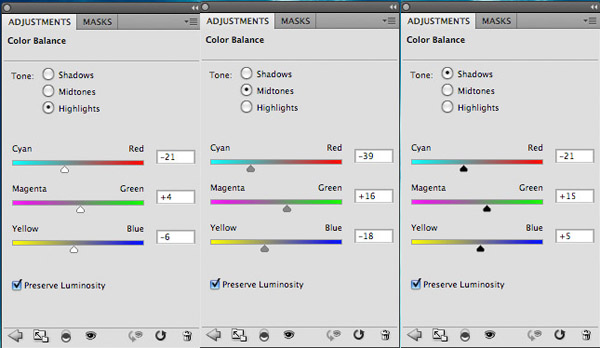
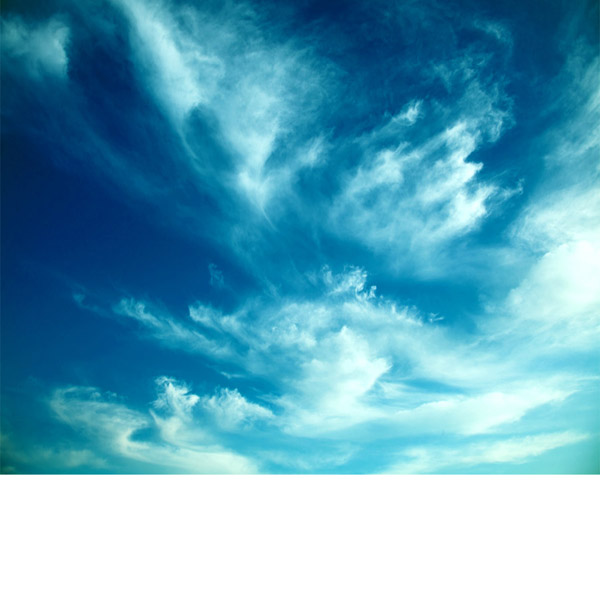 Step 2
Open the ‘grassy field’ image from the resources section for this tutorial.
Paste the image into your original document and position it at the bottom part of your canvas:
Step 2
Open the ‘grassy field’ image from the resources section for this tutorial.
Paste the image into your original document and position it at the bottom part of your canvas:
 Apply a layer mask and use a soft, black paintbrush to mask off the top of your grassy field image. The idea is to let it look as if the underlying sky image is the actual sky for this scene.
Be sure to keep the sign post area in tact and don’t mask this off:
Apply a layer mask and use a soft, black paintbrush to mask off the top of your grassy field image. The idea is to let it look as if the underlying sky image is the actual sky for this scene.
Be sure to keep the sign post area in tact and don’t mask this off:
 Apply a levels and color balance adjustment layer to your green field layer:
Levels Adjustment Layer Settings:
19 / 1.00 / 236
Color Balance Adjustment Layer Settings:
Highlights: -16 / -8 / -26
Apply a levels and color balance adjustment layer to your green field layer:
Levels Adjustment Layer Settings:
19 / 1.00 / 236
Color Balance Adjustment Layer Settings:
Highlights: -16 / -8 / -26Midtones: -22 / +4 / -4
Shadows: -4 / +26 / -25

 Step 3
Open up the ‘old boots’ image from the resources section for this tutorial. Cut out one of the boots using your preferred selection method and paste it into your original document, positioning it like this:
Step 3
Open up the ‘old boots’ image from the resources section for this tutorial. Cut out one of the boots using your preferred selection method and paste it into your original document, positioning it like this:
 We want to get rid of the large lace hanging down the side of the boot. You’ll also notice a small light patch on the bottom left of the soul. This was the second boot in the original image, and we want to get rid of this area too.
Use the clone stamp tool to clone over these areas. Start by option+clicking on your boot layer to select it. The marching ants active selection around your boot will mean that non of your cloning efforts will go outside the edges of your boot shape.
Then proceed to use your clone stamp tool like normal to clone out areas of your boot:
We want to get rid of the large lace hanging down the side of the boot. You’ll also notice a small light patch on the bottom left of the soul. This was the second boot in the original image, and we want to get rid of this area too.
Use the clone stamp tool to clone over these areas. Start by option+clicking on your boot layer to select it. The marching ants active selection around your boot will mean that non of your cloning efforts will go outside the edges of your boot shape.
Then proceed to use your clone stamp tool like normal to clone out areas of your boot:
 You can see the result of the cloning process below. I also applied a layer mask and masked off the top of the boot using a large, soft black paintbrush (you’ll see why later in the tutorial):
You can see the result of the cloning process below. I also applied a layer mask and masked off the top of the boot using a large, soft black paintbrush (you’ll see why later in the tutorial):
 Apply a levels and color balance adjustment layer to your boot layer:
Levels Adjustment Layer Settings:
9 / 0.95 / 244
Color Balance Adjustment Layer Settings:
Highlights: -5 / +6 / +2
Apply a levels and color balance adjustment layer to your boot layer:
Levels Adjustment Layer Settings:
9 / 0.95 / 244
Color Balance Adjustment Layer Settings:
Highlights: -5 / +6 / +2Midtones: +16 / +11 / +16
Shadows: -11 / +1 / -9

 Step 4
Create a new layer underneath your boot layer called ‘shadow under boot’.
Use a medium sized, soft black paintbrush (around 20% opacity) to build up a shadow between your boot and the ground:
Step 4
Create a new layer underneath your boot layer called ‘shadow under boot’.
Use a medium sized, soft black paintbrush (around 20% opacity) to build up a shadow between your boot and the ground:
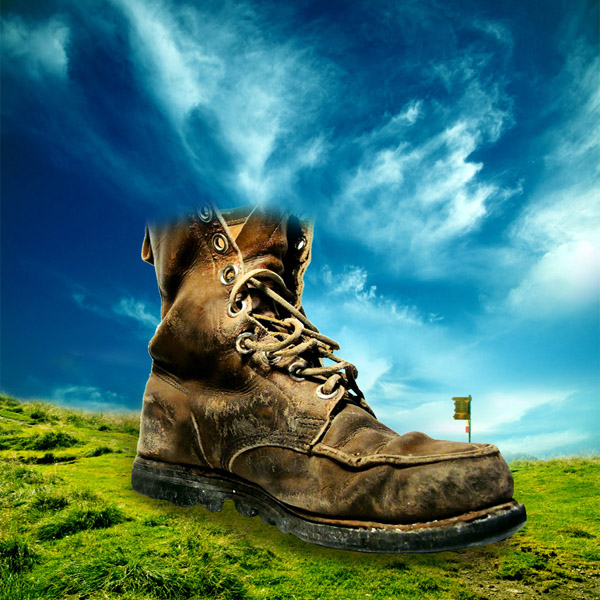 Create a new layer ABOVE your boot layers and call this ‘shadow bottom of boot’.
Apply a further shadow underneath your bottom area, but this time overlap the bottom of your boot slightly, blending the boot into the shadowed area:
Create a new layer ABOVE your boot layers and call this ‘shadow bottom of boot’.
Apply a further shadow underneath your bottom area, but this time overlap the bottom of your boot slightly, blending the boot into the shadowed area:
 Step 5
Open up the ‘door’ image from the resources section for this tutorial. Select the door using your preferred selection method and then paste it into your original document.
Step 5
Open up the ‘door’ image from the resources section for this tutorial. Select the door using your preferred selection method and then paste it into your original document.
 Go to edit>transform>distort and distort your door so that it fits better with the edge of your boot:
Go to edit>transform>distort and distort your door so that it fits better with the edge of your boot:
 Apply a levels, hue/saturation and color balance adjustment layer to your boot layer:
Levels Adjustment Layer Settings:
23 / 0.93 / 241
Hue/Saturation Adjustment Layer Settings:
0 / -20 / 0
Color Balance Adjustment Layer Settings:
Highlights: -56 / -29 / -11
Apply a levels, hue/saturation and color balance adjustment layer to your boot layer:
Levels Adjustment Layer Settings:
23 / 0.93 / 241
Hue/Saturation Adjustment Layer Settings:
0 / -20 / 0
Color Balance Adjustment Layer Settings:
Highlights: -56 / -29 / -11Midtones: -30 / -9 / +12
Shadows: -32 / -6 / +5

 Step 6
Right now our door is looking a little flat and not really part of our boot’s structure.
To fix this, create a new document called ‘shadow over door’.
Use a soft, black paintbrush to paint around the edges of your door, creating the effect than the door is concave into the structure of your boot:
Step 6
Right now our door is looking a little flat and not really part of our boot’s structure.
To fix this, create a new document called ‘shadow over door’.
Use a soft, black paintbrush to paint around the edges of your door, creating the effect than the door is concave into the structure of your boot:
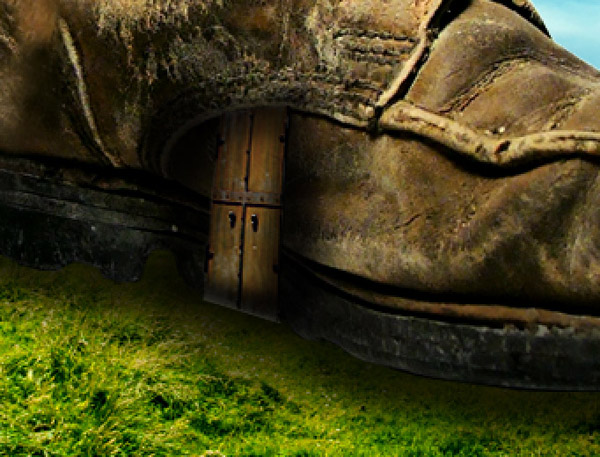 Download the ‘bell photo’ image from the resources section for this tutorial.
Cut it out from it’s background and paste it into your original document.
Position and resize the bell to fit next to your doorway. The colors are already pretty well blended with your surrounding composition, so no adjustments needed just yet:
Download the ‘bell photo’ image from the resources section for this tutorial.
Cut it out from it’s background and paste it into your original document.
Position and resize the bell to fit next to your doorway. The colors are already pretty well blended with your surrounding composition, so no adjustments needed just yet:
 Step 7
Open up your ‘roof’ image from the resources section for this tutorial.
Extract the roof part of the image from it’s background and paste this into your original document.
The roof is roughly at the right angle, so just use your basic transform tools to manipulate it very slightly to fit the top of your boot better:
Step 7
Open up your ‘roof’ image from the resources section for this tutorial.
Extract the roof part of the image from it’s background and paste this into your original document.
The roof is roughly at the right angle, so just use your basic transform tools to manipulate it very slightly to fit the top of your boot better:
 Apply a levels and color balance adjustment layer to your roof layer:
Levels Adjustment Layer Settings:
22 / 0.81 / 247
Color Balance Adjustment Layer Settings:
Highlights: +12 / +2 / -2
Apply a levels and color balance adjustment layer to your roof layer:
Levels Adjustment Layer Settings:
22 / 0.81 / 247
Color Balance Adjustment Layer Settings:
Highlights: +12 / +2 / -2Midtones: -25 / +6 / -1
Shadows: +12 / -6 / -8

 Step 8
Create a new layer called ‘shadow over roof area’. Use a soft black paintbrush to shadow the bottom part of your roof and the top part of your boot. This should help blend them better together.
Step 8
Create a new layer called ‘shadow over roof area’. Use a soft black paintbrush to shadow the bottom part of your roof and the top part of your boot. This should help blend them better together.
 Step 9
Open up the ‘wooden beams’ image from the resources section for this tutorial.
Select one of the beams using your preferred selection method and copy/paste it back into your original document.
The colors of the beam are pretty well blended already with the rest of our composition, so no adjustments are needed for now.
Step 9
Open up the ‘wooden beams’ image from the resources section for this tutorial.
Select one of the beams using your preferred selection method and copy/paste it back into your original document.
The colors of the beam are pretty well blended already with the rest of our composition, so no adjustments are needed for now.
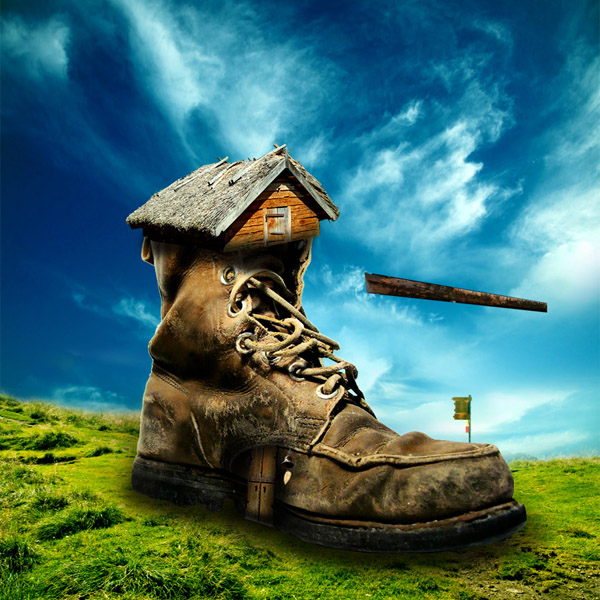 Duplicate the beam several times. Resize and transform each beam to fit as a support for your roof structure:
Duplicate the beam several times. Resize and transform each beam to fit as a support for your roof structure:
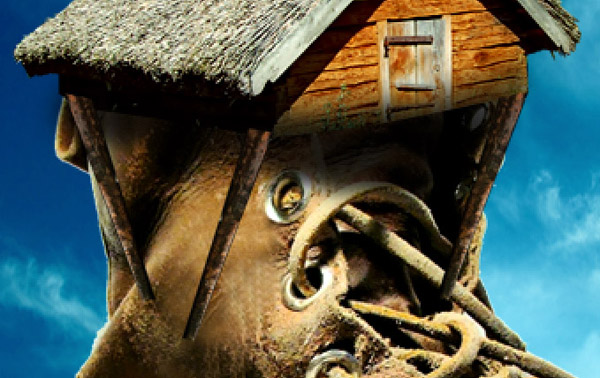 Add a further beam to sit horizontally underneath your roof.
Then create a new layer called ‘shadows blending beams’. Use a soft black paintbrush to add shadows to the top of your beams, blending them better with your roof area.
Finally, apply a layer mask to each of your beam layers. Use a soft black paintbrush to mask off the bottom of each beam, blending it into the leather of your boot:
Add a further beam to sit horizontally underneath your roof.
Then create a new layer called ‘shadows blending beams’. Use a soft black paintbrush to add shadows to the top of your beams, blending them better with your roof area.
Finally, apply a layer mask to each of your beam layers. Use a soft black paintbrush to mask off the bottom of each beam, blending it into the leather of your boot:
 Step 10
Create a new layer beneath your beams called ‘beam shadows’.
Use your lasso tool and paintbucket tool to create some rough black shadows where you anticipate the shadows cast by your beams to go:
Step 10
Create a new layer beneath your beams called ‘beam shadows’.
Use your lasso tool and paintbucket tool to create some rough black shadows where you anticipate the shadows cast by your beams to go:
 Reduce this layer’s opacity to around 55%, and then go to filters>convert for smart filters. This will allow you to apply filters not destructively. Now go to filters>blur>gaussian blur.
Apply a 3.5 pixels strength gaussian blur:
Reduce this layer’s opacity to around 55%, and then go to filters>convert for smart filters. This will allow you to apply filters not destructively. Now go to filters>blur>gaussian blur.
Apply a 3.5 pixels strength gaussian blur:
 Step 11
Open up the big ben clock image from the resources section for this tutorial.
Extract the clock part of the tower, and the square frame surrounding it. Paste this into your original document:
Step 11
Open up the big ben clock image from the resources section for this tutorial.
Extract the clock part of the tower, and the square frame surrounding it. Paste this into your original document:
 You’ll notice that the clock isn’t the right angle to fit with our rooftop right now. This is a pretty easy fix. Simply go to edit>transform>distort and distort your clock until it looks like the image below:
You’ll notice that the clock isn’t the right angle to fit with our rooftop right now. This is a pretty easy fix. Simply go to edit>transform>distort and distort your clock until it looks like the image below:
 Apply a color balance adjustment layer to your clock layer:
Color Balance Adjustment Layer Settings:
Highlights: +11 / +4 / -11
Apply a color balance adjustment layer to your clock layer:
Color Balance Adjustment Layer Settings:
Highlights: +11 / +4 / -11Midtones: +25 / +6 / -16
Shadows: +6 / 0 / -18
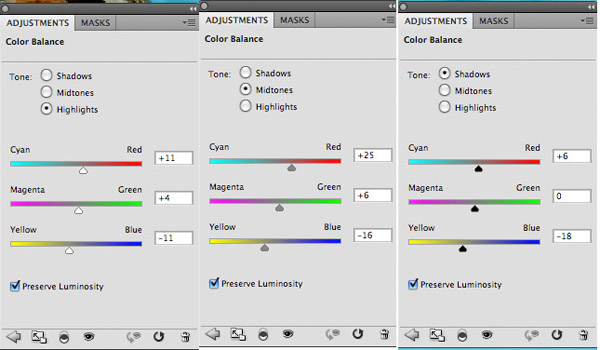 I also created a new layer called ‘shadow clock’ and used a soft, low opacity black paintbrush to add some additional shadow around my clock:
I also created a new layer called ‘shadow clock’ and used a soft, low opacity black paintbrush to add some additional shadow around my clock:
 Step 12
Time to add a chimney to our roof!
Start by opening the ‘chimney’ image in the resources section for this tutorial.
Extract the chimney and paste it back into your original document.
Position the chimney over your roof, and use a layer mask to mask the bottom of the chimney smoothly into your roof area (using a soft black paintbrush for this):
Step 12
Time to add a chimney to our roof!
Start by opening the ‘chimney’ image in the resources section for this tutorial.
Extract the chimney and paste it back into your original document.
Position the chimney over your roof, and use a layer mask to mask the bottom of the chimney smoothly into your roof area (using a soft black paintbrush for this):
 Apply a levels and color balance adjustment layer to your chimney layer:
Levels Adjustment Layer Settings:
20 / 0.79 / 240
Color Balance Adjustment Layer Settings:
Highlights: +16 / +11 / -9
Apply a levels and color balance adjustment layer to your chimney layer:
Levels Adjustment Layer Settings:
20 / 0.79 / 240
Color Balance Adjustment Layer Settings:
Highlights: +16 / +11 / -9Midtones: -13 / -6 / -9
Shadows: +4 / 0 / -8

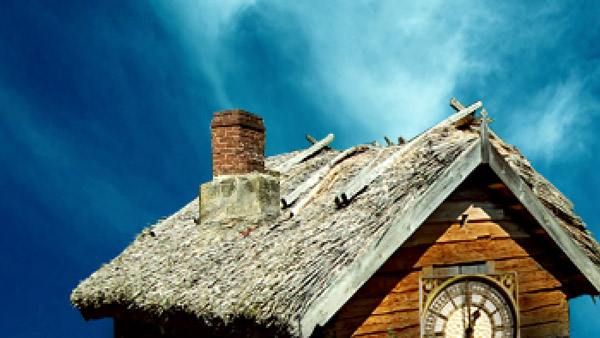 Step 13
Download the ‘FanExtra premium brush set: Clouds’ brush set from the resources section for this tutorial.
Create a new layer called ‘smoke’.
Select one of your cloud brushes and use a white paintbrush to give the impression of smoke rising up from the chimney of the house:
Step 13
Download the ‘FanExtra premium brush set: Clouds’ brush set from the resources section for this tutorial.
Create a new layer called ‘smoke’.
Select one of your cloud brushes and use a white paintbrush to give the impression of smoke rising up from the chimney of the house:
 To make the effect slightly more subtle apply a layer mask and use a low opacity, soft black paintbrush to mask off areas of your smoke:
To make the effect slightly more subtle apply a layer mask and use a low opacity, soft black paintbrush to mask off areas of your smoke:
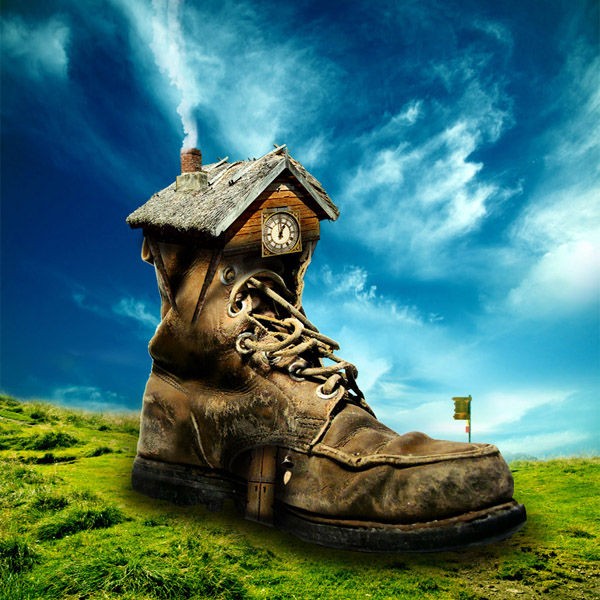 Step 14
Now paste in your ‘window’ image from the resources for this tutorial.
Apply a layer mask and use a soft black paintbrush to mask off the area around your window, blending it more smoothly into your boot’s surface:
Step 14
Now paste in your ‘window’ image from the resources for this tutorial.
Apply a layer mask and use a soft black paintbrush to mask off the area around your window, blending it more smoothly into your boot’s surface:
 Apply a color balance adjustment layer to help blend the colors of the window better:
Color Balance Adjustment Layer Settings:
Highlights: +2 / -4 / -2
Apply a color balance adjustment layer to help blend the colors of the window better:
Color Balance Adjustment Layer Settings:
Highlights: +2 / -4 / -2Midtones: +29 / +12 / -4
Shadows: +21 / +9 / -15
